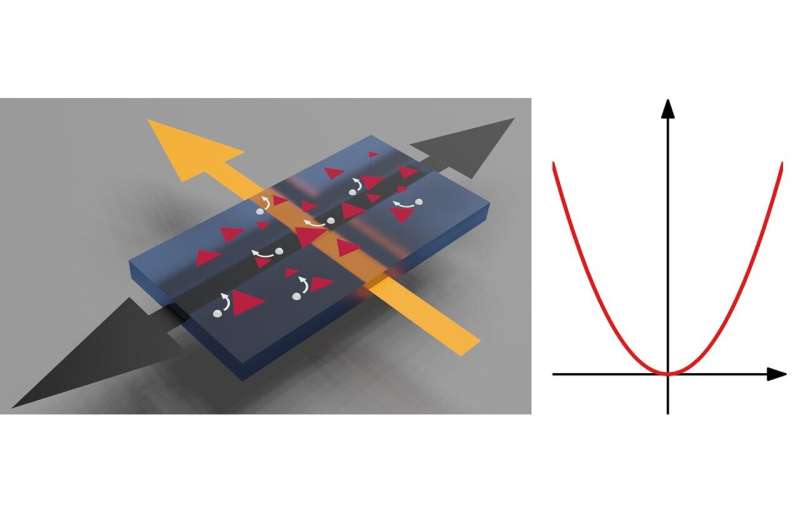An old physical phenomenon known as the Hall effect has revealed some new tricks, according to a team co-led by researchers at Penn State and the Massachusetts Institute of Technology (MIT). They have reported their findings, which they said have potential implications for understanding the fundamental physics of quantum materials and developing applied technologies such as quantum communication and harvesting energy via radio frequencies in Nature Materials.
The conventional Hall effect occurs only in electrical conductors or semiconductors in the presence of a magnetic field. It is characterized by a newly formed voltage, called the Hall voltage, that can be measured perpendicularly to the current and is directly proportional to the applied current.
However, the newly discovered nonreciprocal Hall effect does not require a magnetic field. Discovered by teams led by Zhiqiang Mao, professor of physics, of materials science and engineering and of chemistry at Penn State, and Liang Fu, professor of physics at MIT, this effect is instead denoted by a relationship between the Hall voltage and the applied current that can be described mathematically: The Hall voltage is always proportional to the square of the current. The team made the finding in microstructures composed of textured platinum nanoparticles deposited on silicon.
Unlike the conventional Hall effect, which is driven by a force induced by the magnetic field, the nonreciprocal Hall effect arises from flowing conduction electrons—which are particles that carry the electrical charge—interacting with the textured platinum nanoparticles.
“In this work, we report the first observation of a room-temperature colossal nonreciprocal Hall effect,” Mao said, explaining that pronounced geometric asymmetric scatterings of the textured platinum nanoparticles enabled the observation. “We also showcased the potential application of this effect for broadband frequency mixing and wireless microwave detection. This underscores the vast potential of utilizing nonreciprocal Hall devices for terahertz communication, imaging and energy harvesting.”
The work hinges on understanding how electrons can scatter asymmetrically when interacting with nonsymmetrical particles in a material. This process results in a violation of Ohm’s law, a fundamental tenet described by physicist Georg Ohm in 1827, that states that the current through a conductor is proportional to the applied voltage. Under this law, the Hall voltage should be zero in the absence of a magnetic field. However, Mao said, a nonreciprocal Hall voltage that scales quadratically with current in textured platinum nanoparticles at zero magnetic field challenges this principle.
According to Mao, the finding is even more interesting, because typically, investigations of these behaviors require low temperatures of less than 280 degrees Fahrenheit. However, in this study, the asymmetric structure of the deposited platinum nanoparticles appears to generate the nonreciprocal Hall effect even at room temperature. The work could have potential applications in technologies like quantum rectification, or converting alternating currents to direct current; and photodetection, which involves making electrical signals from light, Mao said.
“This breakthrough deepens our understanding of charge transport in materials,” Mao said, emphasizing that the key to the presence of the nonreciprocal Hall effect in textured platinum nanoparticles is asymmetric electron scattering. “This asymmetry reveals uneven features in what would otherwise be a uniform landscape, and it is in these areas that we are most likely to uncover new insights.”
More information:
Lujin Min et al, Colossal room-temperature non-reciprocal Hall effect, Nature Materials (2024). DOI: 10.1038/s41563-024-02015-7
Provided by
Pennsylvania State University
Citation:
Room-temperature nonreciprocal Hall effect could heat up future technology development (2024, October 24)
retrieved 24 October 2024
from https://phys.org/news/2024-10-room-temperature-nonreciprocal-hall-effect.html
This document is subject to copyright. Apart from any fair dealing for the purpose of private study or research, no
part may be reproduced without the written permission. The content is provided for information purposes only.

